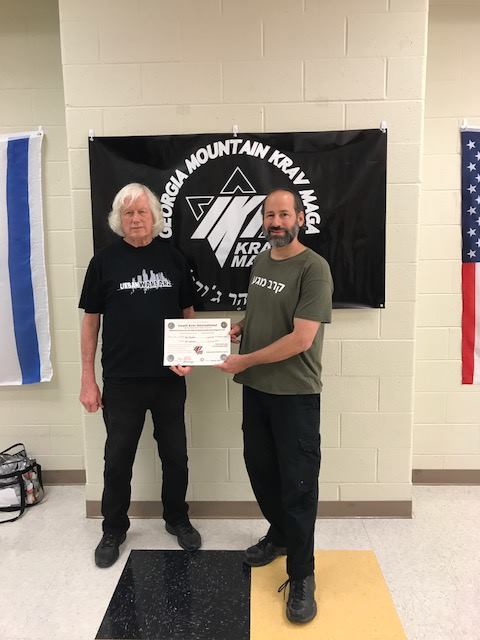- Home
- Krav Maga Blog
- Krav Instructors
- Train in Israel
- Tour Train Israel
- Krav Shop
- DVD
- Kickboxing
- IKI Near Me
- Seminars
- IKI Membership
- On-Line Training
- Krav Maga Training
- Testimonials
- History Krav Maga
- Instructors Page
- Past Blogs
- Spanish
- Italian
- Certification
- Contact
- Holland Seminar
- Vienna Seminar
- Poland Seminar
- Italy Seminar
- Belt Requirements
Joint locks
By Hal Herndon
Chief Instructor
Georgia Mountain Krav Maga
May 7, 2018, Georgia, USA
JOINT LOCKS….THE GOOD, THE BAD AND THE UGLY (one person’s opinion)
Understanding what a joint lock actually is, in concept, is pretty simple and straight forward. Fortunately one can get a pretty good understanding of the concept without a partner and without an intensive study of anatomy…..Here is the concept:
Think about any joint in your personal body (wrist, elbow, shoulder, knee, ankle, etc., etc.) and how it is designed to work…Every joint is designed to move “comfortably” or “efficiently” in certain directions so that it can perform its intended function efficiently. With this as a “given” point of departure, joint lock are simply based on taking or moving or forcing the joint in question to move in a direction totally contrary to what it was designed to do.
Simple example: Elbow joints are designed to “bend” a certain way and we all realize that. If you try to make them bend or move in any other direction, pain and/or various degrees of discomfort or destruction is the result….That is the essence of a joint lock.
Yes indeed, this sounds and seems totally obvious (if it doesn’t, please have someone you trust make any of your joints move or bend in a direction they are not meant to go).
So…in a very simplistic sense, you now know the concept of getting or implementing a joint lock..(arm bar, wrist lock, figure 4 lock or ‘key lock’, ankle lock and all the rest).
However, knowing the concept and making it work are two quite different things…Most joint locks involve not only fine motor skills but a great deal of training and repetition with various partners. They also require one to know instantly when the attempt starts to fail, to know to NEVER chase the technique and instantly go to “Plan B”. (FYI “Plan B” is nothing specific….it is simply based on circumstance, opportunity and your awareness and background but it is definitely NOT chasing a joint lock (or any other technique) and trying to force it to work).
The “downside”: Confrontations are dynamic and kinetic. Typically both parties (or all parties) are moving to one extent or another. Your aggressor will never stand there and just let you implement a joint lock without some degree of resistance. The person you try the joint lock on may be sweaty, may have slick or bulky clothes or may just be fast and strong so he can pull away the second you start. All of this and more needs to be factored in to the attempt scenario. Even some of us who have practiced joint locks for decades run into people with reflexes such that they instantly and violently resist once you start (even in a controlled environment like a dojo). If you chase the technique and try to muscle your way through to achieve the lock, typically you will not only fail at the attempt but you will also likely get hammered by the aggressor in the process. Once the attempt “goes south” you become a relatively easy target if you persist in trying to implement it.
Of course there are counter techniques which will negate or reverse a joint lock. We learn them in advanced HapKiDo training and they are very informative (and frankly fun to “play with”). The unfortunate thing about these counters is that you not only have to be super-fast reacting to the aggressor’s attempt at the joint lock, you also have to instinctively and instantly know what lock he is trying to implement. Rest assured that if the party attempting the joint lock has practiced doing them for many years and applies them aggressively you simply will not have time to counter. Conversely your instincts may well allow you to pull away. Then again, how many street thugs really have a clue and could pull off an instant and effective traditional joint losk?
This dialogue could go on for a good while but hopefully you get the picture. What we (at GMKM) do is teach the students the very basic components and principles of a few relatively easy joint locks BUT we emphasize that if they start out trying to do one with an actually aggressive dynamic attacker they are probably going to fail. What we do is teach the student what to look for. In a dynamic situation, if you are aware of and understanding of what is happening (i.e., observant) there are often situations and position that present themselves as “gifts” from which you can implement a very effective joint lock with no effort at all and frankly a relative minimum of training. Knowing what to look for is a key to this idea. Note here also, however, that if the “gift” starts to fail to work for you it is critical that you instantly drop the idea and go to whatever “plan B” is in your toolbox. You will not have time to plan or determine options…You simply have to “do it” (whatever it may be, e.g., a strike, kick, bite, eye gouge, elbow or just run…).

Hal Herndon, IKI Master Instructor, Georgia, USA